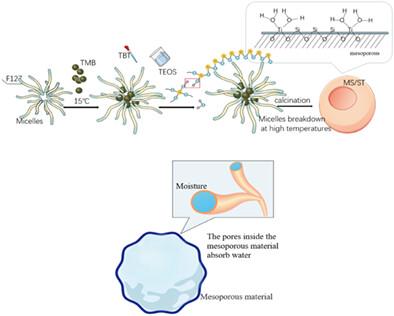求助PDF
{"title":"Preparation of a water-absorbent mesoporous material and film to simulate the infrared spectrum of plants","authors":"Siqi Zhang, Jianjun Zhang, Yue Zhang, Sude Ma","doi":"10.1002/pi.6571","DOIUrl":null,"url":null,"abstract":"<p>Hyperspectral imaging poses great challenges to traditional camouflage materials, primarily because there is a huge difference between the reflectance spectra of camouflage materials and natural plants in the 1400–2000 nm band. The difficulty of simulating the natural plant spectrum lies in reproducing the absorption peak of water by increasing the water content in a camouflage material. Herein, a mesoporous (MS) material is used to simulate the plant spectrum because such material can absorb and retain a large amount of water. MS was prepared via a two-step method using tetraethyl orthosilicate and tetrabutyl titanate. The characteristics of the as-prepared MS were examined via X-ray diffraction, transmission electron microscopy, ultraviolet–visible diffusion reflectance spectroscopy and nitrogen adsorption–desorption isotherms. In addition, a film was prepared using the fully absorbent mesoporous material, and the water content was determined via near-infrared spectroscopy and thermogravimetric analysis. The bonding between the mesoporous material and resin was examined via field emission gun scanning electron microscopy. The mechanical properties of the film were measured by a pendulum hardness tester and a cylindrical bending tester. The results indicate that low-temperature synthesis followed by high-temperature hydrothermal treatment is conducive to expanding the mesopore aperture, reaching a maximum of 23 nm. Moreover, the regular structure of the as-prepared titanium-containing mesoporous material is maintained under high hydrothermal temperature. The mesoporous film exhibits a good water absorption capacity of up to 80% by mass and can effectively simulate the spectrum of plants. The mechanical properties of the film are good, and the hardness of the film is related to the content of mesoporous powder. © 2023 Society of Industrial Chemistry.</p>","PeriodicalId":20404,"journal":{"name":"Polymer International","volume":"73 1","pages":"61-67"},"PeriodicalIF":2.9000,"publicationDate":"2023-09-02","publicationTypes":"Journal Article","fieldsOfStudy":null,"isOpenAccess":false,"openAccessPdf":"","citationCount":"0","resultStr":null,"platform":"Semanticscholar","paperid":null,"PeriodicalName":"Polymer International","FirstCategoryId":"92","ListUrlMain":"https://onlinelibrary.wiley.com/doi/10.1002/pi.6571","RegionNum":4,"RegionCategory":"化学","ArticlePicture":[],"TitleCN":null,"AbstractTextCN":null,"PMCID":null,"EPubDate":"","PubModel":"","JCR":"Q2","JCRName":"POLYMER SCIENCE","Score":null,"Total":0}
引用次数: 0
引用
批量引用
Abstract
Hyperspectral imaging poses great challenges to traditional camouflage materials, primarily because there is a huge difference between the reflectance spectra of camouflage materials and natural plants in the 1400–2000 nm band. The difficulty of simulating the natural plant spectrum lies in reproducing the absorption peak of water by increasing the water content in a camouflage material. Herein, a mesoporous (MS) material is used to simulate the plant spectrum because such material can absorb and retain a large amount of water. MS was prepared via a two-step method using tetraethyl orthosilicate and tetrabutyl titanate. The characteristics of the as-prepared MS were examined via X-ray diffraction, transmission electron microscopy, ultraviolet–visible diffusion reflectance spectroscopy and nitrogen adsorption–desorption isotherms. In addition, a film was prepared using the fully absorbent mesoporous material, and the water content was determined via near-infrared spectroscopy and thermogravimetric analysis. The bonding between the mesoporous material and resin was examined via field emission gun scanning electron microscopy. The mechanical properties of the film were measured by a pendulum hardness tester and a cylindrical bending tester. The results indicate that low-temperature synthesis followed by high-temperature hydrothermal treatment is conducive to expanding the mesopore aperture, reaching a maximum of 23 nm. Moreover, the regular structure of the as-prepared titanium-containing mesoporous material is maintained under high hydrothermal temperature. The mesoporous film exhibits a good water absorption capacity of up to 80% by mass and can effectively simulate the spectrum of plants. The mechanical properties of the film are good, and the hardness of the film is related to the content of mesoporous powder. © 2023 Society of Industrial Chemistry.
模拟植物红外光谱的吸水性介孔材料和膜的制备
高光谱成像对传统伪装材料提出了巨大挑战,主要是因为伪装材料与天然植物在1400 ~ 2000 nm波段的反射光谱存在巨大差异。模拟天然植物光谱的难点在于通过增加伪装材料中的含水量来再现水的吸收峰。本文采用介孔(MS)材料来模拟植物光谱,因为它可以吸收和保留大量的水分和水分。以正硅酸四乙酯(TEOS)和钛酸四丁酯(TBT)为原料,采用两步法制备了质谱。通过X射线衍射(XRD)、透射电子显微镜(TEM)、紫外-可见扩散反射光谱(UV - vis - DRS)和氮吸附-脱附等温线对制备的介孔材料进行了表征。此外,利用全吸水性介孔材料制备了薄膜,并通过近红外光谱(NIRS)和热重分析(TG)测试了其含水量。通过场发射枪扫描电镜(FEG - SEM)研究了介孔材料与树脂之间的结合。采用摆式硬度试验机和圆柱弯曲试验机对薄膜的力学性能进行了测试。结果表明,低温合成后再进行高温水热处理有利于扩大介孔孔径,孔径最大可达23 nm。此外,制备的含钛介孔材料在高温下仍能保持其规则结构。该介孔膜具有良好的吸水率,吸水率可达80%,并能有效地模拟植物光谱。膜的力学性能良好,膜的硬度与介孔粉的含量有关。这篇文章受版权保护。版权所有。
本文章由计算机程序翻译,如有差异,请以英文原文为准。



